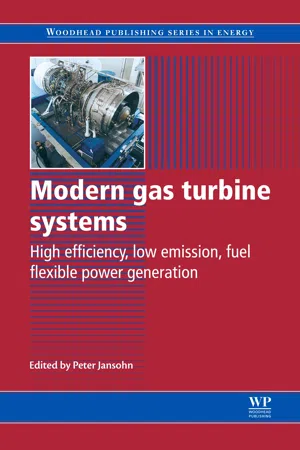
Modern Gas Turbine Systems
High Efficiency, Low Emission, Fuel Flexible Power Generation
- 838 pages
- English
- ePUB (mobile friendly)
- Available on iOS & Android
Modern Gas Turbine Systems
High Efficiency, Low Emission, Fuel Flexible Power Generation
About this book
Modern gas turbine power plants represent one of the most efficient and economic conventional power generation technologies suitable for large-scale and smaller scale applications. Alongside this, gas turbine systems operate with low emissions and are more flexible in their operational characteristics than other large-scale generation units such as steam cycle plants. Gas turbines are unrivalled in their superior power density (power-to-weight) and are thus the prime choice for industrial applications where size and weight matter the most. Developments in the field look to improve on this performance, aiming at higher efficiency generation, lower emission systems and more fuel-flexible operation to utilise lower-grade gases, liquid fuels, and gasified solid fuels/biomass. Modern gas turbine systems provides a comprehensive review of gas turbine science and engineering.The first part of the book provides an overview of gas turbine types, applications and cycles. Part two moves on to explore major components of modern gas turbine systems including compressors, combustors and turbogenerators. Finally, the operation and maintenance of modern gas turbine systems is discussed in part three. The section includes chapters on performance issues and modelling, the maintenance and repair of components and fuel flexibility.Modern gas turbine systems is a technical resource for power plant operators, industrial engineers working with gas turbine power plants and researchers, scientists and students interested in the field.- Provides a comprehensive review of gas turbine systems and fundamentals of a cycle- Examines the major components of modern systems, including compressors, combustors and turbines- Discusses the operation and maintenance of component parts
Frequently asked questions
- Essential is ideal for learners and professionals who enjoy exploring a wide range of subjects. Access the Essential Library with 800,000+ trusted titles and best-sellers across business, personal growth, and the humanities. Includes unlimited reading time and Standard Read Aloud voice.
- Complete: Perfect for advanced learners and researchers needing full, unrestricted access. Unlock 1.4M+ books across hundreds of subjects, including academic and specialized titles. The Complete Plan also includes advanced features like Premium Read Aloud and Research Assistant.
Please note we cannot support devices running on iOS 13 and Android 7 or earlier. Learn more about using the app.
Information
Introduction to gas turbines
Abstract:
1.1 Introduction
1.2 The importance of gas turbines for worldwide CO2 reduction

Table of contents
- Cover image
- Title page
- Table of Contents
- Copyright
- Contributor contact details
- Woodhead Publishing Series in Energy
- Part I: Overview of modern gas turbine systems
- Part II: Modern gas turbine systems and major components
- Part III: Operation and maintenance of modern gas turbine systems
- Index